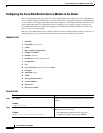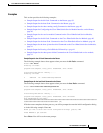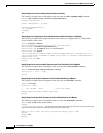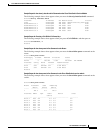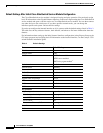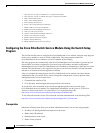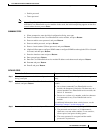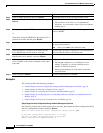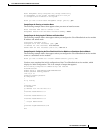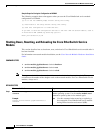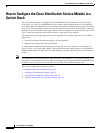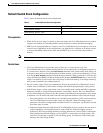
Cisco EtherSwitch Service Modules Feature Guide
How to Configure the Cisco EtherSwitch Service Module
44
Cisco IOS Release 12.2(25)SEC
Configuring the Cisco EtherSwitch Service Module Using the Switch Setup
Program
This section describes how to configure the Cisco EtherSwitch service module, using the setup program
on the service module to create an initial configuration. The setup program enables the
Cisco EtherSwitch service module to run on its standard default settings.
The setup program runs automatically after the Cisco EtherSwitch service module is powered up, but
does not have an existing configuration. You must assign an IP address and other configuration
information necessary for the Cisco EtherSwitch service module to communicate to other devices on the
network. This information is also required if you plan to use the Cisco Network Assistant (hereafter
referred to as Network Assistant) application software.
After you complete the setup program, the Cisco EtherSwitch service module can run the default
configuration that you created. If you want to change this configuration or want to perform other
management tasks, use one of these tools:
• Command-line interface (CLI)
• Cisco Network Assistant application program from your browser
To use the CLI, enter commands at the switch> prompt through the console session to the
Cisco EtherSwitch service module. For configuration information, see the Catalyst 3750 Switch
Software Configuration Guide, Cisco IOS Release 12.2 at the following URL:
http://www.cisco.com/univercd/cc/td/doc/product/lan/cat3750/index.htm
To use Network Assistant, see the Cisco Network Assistant documentation at the following URL:
http://www.cisco.com/univercd/cc/td/doc/product/rtrmgmt/cna/v2_0/index.htm
Prerequisites
Obtain the following items from your network administrator before you start the setup program:
• IP address for the Gigabit Ethernet interface on the router
• Subnet mask (IP netmask)
• Default gateway of the router
• Enable secret password
1. Only if the device acting as a DCHP server is configured and enabled.
2. Only if the device acting as a DHCP relay agent is configured and enabled.
3. DNS = Domain Name System
4. VTP = VLAN Trunking Protocol
5. STP = Spanning Tree Protocol
6. PVST+ = Per VLAN Spanning Tree Enhanced
7. MSTP = Multi-service Transport Platforms
8. IGMP = Internet Group Management Protocol
9. CDP = Cisco Discovery Protocol
10. UDLD = Unidirectional Link Detection Protocol
11. SPAN = Local Switch Port Analyzer
12. RSPAN = Remote Switch Port Analyzer
13. RMON = Remote Monitoring
14. MSDP = Multicast Source Discovery Protocol



